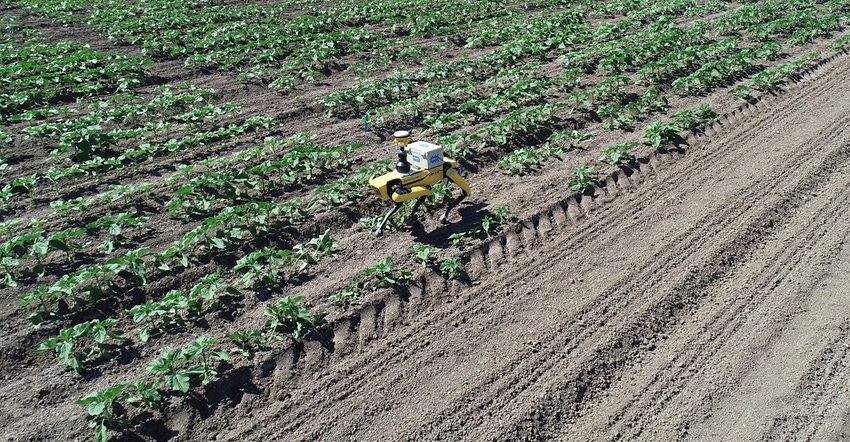July 30, 2021

Editor’s note: You can see a video of this field robot at work at the end of this story.
When someone sees a dog in a crop field, they think nothing of it. But what if it was a robotic “dog” walking in a precise pattern up and down every row capturing detailed imagery of the crop? That vision might be more common someday, and one seed company is making it happen today.
Corteva Agriscience is laying claim to being among the first in agriculture to use a new agile robotic platform to walk between rows of corn, sunflowers and other crops. But it all started nearly a decade ago with drones.
“We were doing a lot of images in our trials,” recalls Geoff Graham, leader of seed product development for Corteva Agriscience. “We had been using drones for a long period of time, and somewhere around 2010 or 2011, I had this idea that as we start taking notes, we should be taking notes with images, with drones.”
The seed industry has increasingly turned to more precise and detailed data as a key part of the development of new hybrids and varieties. Matching imagery with field notes helps improve the precision of evaluating new products, and the drone imagery helped ramp up the data captured, Graham explains.
The drones provided solid imagery of the crop from above, but as the canopy closed, the value of that imagery slipped. “There’s so much that happens underneath the canopy,” he says. So the company started looking at how to get beneath the canopy.
Graham and his colleagues were looking at a variety of options when he saw a “60 Minutes” story about Boston Dynamics and its development of new agile robotic technology. This is the company that’s known for its dancing robot, along with Spot, a dog-like robot that can move across difficult terrain and carry data-gathering tools at the same time.
When Graham saw the Boston Dynamics story, his first thought? “We should get one; we should give some of these things a try,” he says. “So we started exploring the possibilities about how robots can actually start taking data and doing so much more than that.”
A ‘ground drone’ approach
When he talks about the use of the Spot robot — which has been named Anatoly, or Annie — Graham shares some enthusiasm about the potential of this technology: “You run good plots; then you get good images going through there. And then you combine those images with things like artificial intelligence to be able to handle the information. You start thinking about what a farmer wants and correlate that back to the traits and attributes that [Annie] sees.”
Corteva and Boston Dynamics worked closely on fine-tuning Annie for fieldwork. “When we first got it, the robot had trouble walking through the field with stubble,” Graham recalls.
That was fixed, and in a demonstration video, the company shows the machine walking confidently through a freshly tilled cornfield with some soft conditions. These machines can be “trained” to work in a wide range of environments.
Graham notes that if you watch Annie moving through the field, it’s hard to see how many sensors the robot carries. It can take 360-degree detailed imagery in the canopy of any crop being evaluated. And while a drone can provide precision imagery, this “on-the-ground drone” captures even more.
It can also work under extreme heat, which is common at the peak times of the year when plot evaluation occurs, taking some of the stress away from data gathering during plot evaluation. This also protects employees from potentially dangerous situations.
And Graham says that those in-plot reviews are valuable in rating a product. For example, the small-plot development work Pioneer does often has plants on the outer edge standing taller, but information about plants deep in the plot may show the same hybrid doesn’t perform well when competing with its neighbors. That knowledge is easier to gather and helps evaluate what may move to the next step in product development.
Autonomy and GPS precision
This is a machine that can count individual pods on soybean plants as it walks its course through field plots. Graham says the robot can follow a glide path through a plot working autonomously as it goes.
“Annie’s proximal sensing capabilities and ability to execute specific actions at a certain plot or by individual plant will help us challenge assumptions about the way things are done,” he adds.
There’s a third partner in this robot adventure. Trimble is providing precise GPS guidance technologies on the Spot platform. Graham says the same GPS is used on the plot planters creating precise maps of each plot that can later be used to build that glide path for the robot.
“So then you know how to navigate through alleyways and through rows based on that GPS data set,” Graham says.
And as for that name Anatoly? The robot is named after Pioneer founder Henry A. Wallace’s beloved Anatolian shepherd dogs.
About the Author(s)
You May Also Like






